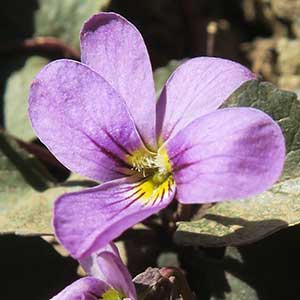Viola flettii
Viola nephrophylla
Flett's violet, Olympic violet, rock violet
kidney-leaf violet, Leconte violet, northern bog violet, violette néphrophylle
1–3, ascending to erect, mostly glabrous, on caudex from fleshy rhizome.
basal and cauline;
basal: 1–3;
stipules linear-lanceolate, margins entire or with glandular processes, apex acuminate;
petiole 1.5–9.7 cm, mostly glabrous;
blade purple-tinted and –veined, broadly reniform to ovate, 0.9–2.4 × 1.2–4 cm, base cordate, margins finely crenate-serrate, eciliate, apex acute to obtuse, surfaces glabrous or sparsely pubescent along veins adaxially;
cauline similar to basal except: stipules ovate to lanceolate, margins entire or shallowly laciniate;
petiole 0.7–5.9 cm, usually glabrous;
blade 0.8–2.1 × 1.2–3.1 cm.
basal, 4–7, ascending to erect;
stipules lanceolate, margins entire or fimbriate, apex acute;
petiole 2–25 cm, usually glabrous;
blade usually grayish green or purplish green abaxially, unlobed, ovate, reniform, or broadly reniform to orbiculate, 1–7 × 1–7 cm, somewhat fleshy, base broadly cordate or reniform to ± truncate, margins crenate to serrate, ciliate or eciliate, apex acute to obtuse or rounded, surfaces usually glabrous, rarely sparsely pubescent.
1.8–7.1 cm, usually glabrous.
3–25 cm, usually glabrous.
sepals lanceolate, margins eciliate, auricles 0.5–1.5 mm;
petals soft reddish violet on both surfaces, all with yellow area basally, lower 3 dark violet-veined, lateral 2 bearded, lowest with white around yellow area, 10–15 mm, spur yellow, gibbous, 0.5–2 mm;
style head bearded; cleistogamous flowers axillary.
sepals ovate, margins usually eciliate, auricles 1–2 mm;
petals deep bluish violet on both surfaces, lower 3 white basally and darker violet-veined, lateral 2 bearded, upper 2 sometimes sparsely bearded, lowest densely bearded or beardless, 10–28 mm, spur same color as petals, gibbous, 2–3 mm;
style head beardless; cleistogamous flowers on erect to ascending peduncles.
± spherical, 5–9 mm, glabrous.
ovoid, 5–10 mm, glabrous.
dark brown to brownish purple, 2.5–3 mm.
beige to brown or dark brown, 1.5–2.5 mm.
= 54.
Viola flettii
Viola nephrophylla
Viola flettii is endemic to the Olympic Mountains of northwestern Washington. C. S. McCreary (2005) noted that although morphologically and ecologically distinct, V. cuneata, V. flettii, and V. ocellata are closely related.
(Discussion copyrighted by Flora of North America; reprinted with permission.)
Viola nephrophylla has the widest distribution in North America of any of the acaulescent blue violets.
There is some question whether the species we now know as Viola nephrophylla fits with the protologue and type specimen(s). McKinney examined the type designated by Greene; it appears that what most botanists have called V. nephrophylla may be an undescribed taxon. N. L. Gil-Ad (1997) believed Greene’s type contained plants that were genetically impure based on seed coat micromorphology and suggested the specimens might be a mixture of both orthospecies and introgressants.
Viola mccabeiana was described by M. S. Baker in 1940 from collections made in British Columbia. Later, Baker (1949b) discussed the reasons why the name V. mccabeiana needed to be abandoned. C. L. Hitchcock et al. (1955–1969, vol. 3) treated V. mccabeiana as synonymous with V. nephrophylla var. cognata. While Viola mccabeiana is recognized in Canada (L. Brouillet et al., http://data.canadensys.net/vascan/), we believe it is best included within V. nephrophylla.
Viola nephrophylla reportedly hybridizes with V. cucullata (= V. ×insessa House), V. sororia var. sororia (= V. ×napae House), and V. affinis (= V. ×subaffinis House).
(Discussion copyrighted by Flora of North America; reprinted with permission.)
- Local floras:
BC,
CA,
OR,
WA
- Local Web sites:
CalFlora,
CalPhotos,
Flora NW,
Go Botany,
IL Wildflowers,
KS Wildflowers,
MI Flora,
MN Wildflowers,
PNW Herbaria,
SW CO Wildflowers
WildflowerSearch
iNaturalist (observations)
USDA Plants Database
- LBJ Wildflower Center
- SEINet
- Plants of the World Online
- Encyclopedia of Life
- Wikipedia
- Google Image Search


